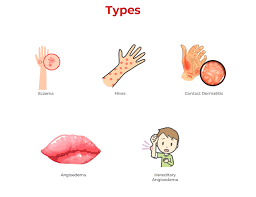
Allergy in Ayurveda
Introduction
Ayurveda, the ancient Indian system of medicine, offers a holistic approach to health and well-being. In this article, we delve into the realm of Ayurveda and explore its perspective on allergies. Understanding how Ayurveda views allergies can provide valuable insights into personalized and effective management. According to Ayurveda, there are two different types of allergy – these are allergy due to sensitivity and allergy due to excess toxins. Allergic rhinitis, which is very common today is an allergy due to sensitivity of nasal system. Allergic rashes are comes under title of allergy due to excess toxins.
In Ayurveda, the three doshas—Vata, Pitta, and Kapha—play a crucial role in maintaining balance within the body. Imbalances in these doshas are believed to contribute to various health issues, including allergies. The strength of one’s digestive fire, known as Agni, Sensitivity and the accumulation of toxins, or Ama, also factor into the Ayurvedic understanding of allergies.
Causes of Allergies in Ayurveda
In Ayurveda, the causes of allergies are diverse and may include:
1. Imbalances in the doshas (Vata, Pitta, Kapha).
2. Compromised digestive function.
3. Accumulation of ama (toxins) in the body.
4. Sensitivity to specific substances or allergens.
5. Individual constitution (Prakruti) influencing susceptibility.
6. State of the immune system.
Identifying and addressing these factors is crucial in the Ayurvedic approach to managing and preventing allergies.
Identifying Allergies in Ayurveda
Symptoms of allergies in Ayurveda are often categorized based on the dominant dosha imbalance. like –
- Vata imbalance – breathlessness, blackish discoloration on skin
- Pitta imbalance – Rashes, oedema, rhinitis
- Kapha imbalance – swelling, headache, heaviness in body
Additionally, practitioners use methods like pulse diagnosis, Ashtavidha Pariskshan, Hetu Parikshan and tongue examination for a more personalized approach to identifying allergies.
Ayurvedic Approach to Managing Allergies
Ayurvedic treatments for allergies involve dietary modifications, herbal remedies, lifestyle adjustments and many more. These natural interventions aim to restore balance within the body, addressing the root cause of allergic reactions.
- Dietary Modifications:
- Adopting a diet that pacifies the aggravated dosha, particularly focusing on foods that are easy to digest.
- Avoiding or minimizing consumption of allergenic foods. (cold drinks, curd, sugarcane juice, jiggery, Salad, fridge product etc.)
- Herbal Remedies:
- Herbs with anti-inflammatory and immunomodulatory properties, such as Triphala, Tulsi (Holy Basil), and Turmeric.
- Nasal irrigation with saline solutions containing herbs like Neem or Guduchi.
- Ayurvedic formulations like Sitopaladi Churna or Talisadi Churna may be recommended to alleviate respiratory symptoms.
- Consult with us for personalized herbal formulations based on individual constitution.
- Lifestyle Adjustments:
- Incorporating regular exercise to improve overall immunity and reduce stress.
- Establishing a daily routine (Dinacharya) to promote balance and well-being.
- Yoga and Pranayama:
Yoga Asanas: Practicing yoga postures that enhance respiratory function and improve lung capacity.Sukhasana (Easy Pose):
- A simple cross-legged sitting posture to promote relaxation and focus on breath.
Bhujangasana (Cobra Pose):
- Strengthens the spine and opens the chest, aiding in respiratory function.
Setu Bandhasana (Bridge Pose):
- Stretches the chest and improves lung capacity.
Adho Mukha Svanasana (Downward-Facing Dog):
- Encourages blood circulation, relieves sinus congestion, and strengthens the respiratory muscles.
Viparita Karani (Legs Up the Wall Pose):
- Promotes relaxation and reduces inflammation.
Balasana (Child’s Pose):
- A restorative pose that helps relieve stress and tension.
Pranayama Techniques: Incorporating pranayama techniques, especially Nadi Shodhana (Alternate Nostril Breathing), to balance energy channels.
Nadi Shodhana (Alternate Nostril Breathing):
- Balances the flow of energy and helps clear the nasal passages.
Kapalbhati Pranayama (Skull Shining Breath):
- Cleanses the respiratory system and energizes the body.
Bhramari Pranayama (Bee Breath):
- Calms the nervous system and may alleviate symptoms of allergy.
Ujjayi Pranayama (Victorious Breath):
- Deep, oceanic breath that promotes focus and relaxation.
Sheetali Pranayama (Cooling Breath):
- A cooling breath that may help soothe inflammation.
- Detoxification Therapies:
Prevention of Allergies in Ayurveda
Ayurveda emphasizes preventive measures, including seasonal routines and detoxification practices, to minimize the likelihood of developing allergies.
Case Studies
Name – Rashida D. Age 56/F ; Having history of allergic rhinitis from last two and half year. She was on cetrizine tablet. Even if she started cetrizine, her complaints was not much controlled. When she came at our hospital, I completely observed her daily diet and routine. I found that she is taking 2 glasses of normal water just after wake up. I advised to stop that. and started Nasya therapy. Within a week, her complaints got reduced significantly. She stopped her previous medicine in just 3 days after my Nasya therapy. I given her Nasya for 45 days. After that she was completely fine. Then advised dietary recommendation based on her prakruti (Pitta pradhan prakruti) to follow for next 3 months.
Common Myths about Ayurvedic Allergy Treatment
- Myth: Ayurvedic treatments take a long time to show results.
- Fact: The duration of treatment varies based on individual factors, but Ayurvedic therapies can provide relief and improvements in a reasonable timeframe.
- Myth: Ayurveda only uses herbal remedies for allergy treatment.
- Fact: While herbs play a significant role, Ayurvedic treatment also involves dietary modifications, lifestyle changes, and therapies tailored to the individual’s unique constitution.
- Myth: Ayurvedic treatment is not scientific.
- Fact: Ayurveda is rooted in ancient wisdom but incorporates scientific principles. Many Ayurvedic practices align with modern medical understanding and are evidence-based.
- Myth: Ayurvedic treatment is only about symptom management.
- Fact: Ayurveda aims to address the root cause of ailments, providing holistic healing rather than merely alleviating symptoms.
- Myth: Ayurvedic treatment is not suitable for acute conditions.
- Fact: Ayurveda can be adapted for acute conditions, providing supportive care alongside conventional medical treatment.
- Myth: Ayurvedic treatment is a one-size-fits-all approach.
- Fact: Ayurveda emphasizes personalized care. Treatments are tailored based on an individual’s unique constitution (Prakruti) and current imbalances (Vikruti).
- Myth: Ayurvedic treatments are expensive.
- Fact: Not truly. Ayurvedic treatments can be cost-effective compared to certain modern medical interventions. However, costs may vary based on the type of treatment.
Frequently Asked Questions (FAQs)
A1. Doshas, or constitutional energies in Ayurveda, play a crucial role in maintaining balance within the body. Imbalances in doshas can contribute to the development of allergies.
A2. While Ayurveda aims to provide relief and manage allergies effectively, claiming complete cure depends on various factors. Individual responses to treatment may vary.
A3. The timeline for results with Ayurvedic treatments varies based on individual factors, the severity of allergies, and adherence to prescribed regimens.
A4. Ayurvedic remedies are generally considered safe when prescribed by qualified practitioners. However, individual reactions may vary, and it’s essential to consult with an Ayurvedic expert.
A5. Integrating Ayurveda with conventional allergy treatments is possible and may offer a more comprehensive approach to managing allergies. Consultation with healthcare providers from both fields is recommended
Uniqueness of our therapies
At Arogya Mandir – Shri Siddhanath Ayurvedic Hospital, Miraj, we delve deeply into the ayurvedic examination of each patient. Utilizing noninvasive Ayurvedic diagnostic tools such as Ashtavidha Parikshan and Nadi Parikshan, we precisely determine the pathogenesis of the disease and then prescribe therapies tailored to the specific condition. This approach leads to expedited results.
Our therapies boast the following distinctive features:
– Tranquil and hygienic therapy rooms staffed with trained therapists in a positive environment.
– Selection of appropriate massage oil based on the patient’s Prakruti and the condition of the disease.
– Complimentary Prakruti and Dhatu Sarata examinations before the commencement of therapies.
– Authenticated procedures for each therapy.
– Judicious use of herbal medicines and instruments during the therapy sessions.
– Specialized rooms equipped with all facilities for inpatient care.
Feel free to share this article at no cost.
Copyright message – Dr. Prashant Chivate has published this article on drchivateayurved.org for informational purposes about diseases. Any other use of this article is strictly prohibited. All rights reserved.
